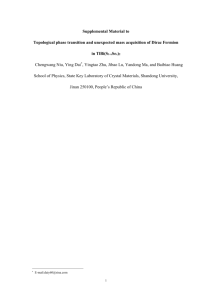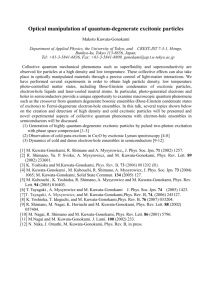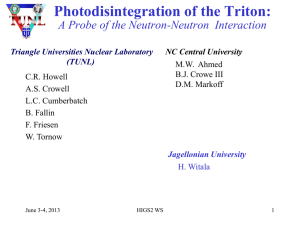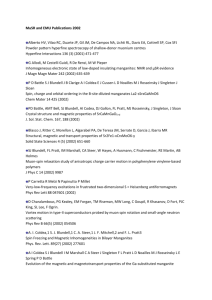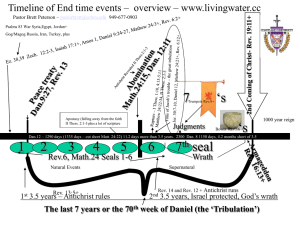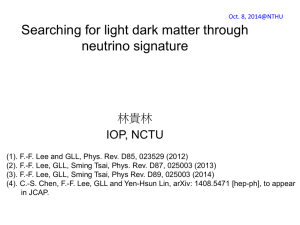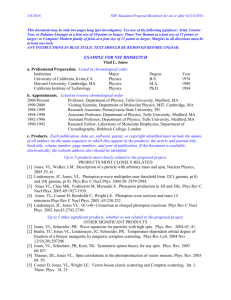pptx
advertisement
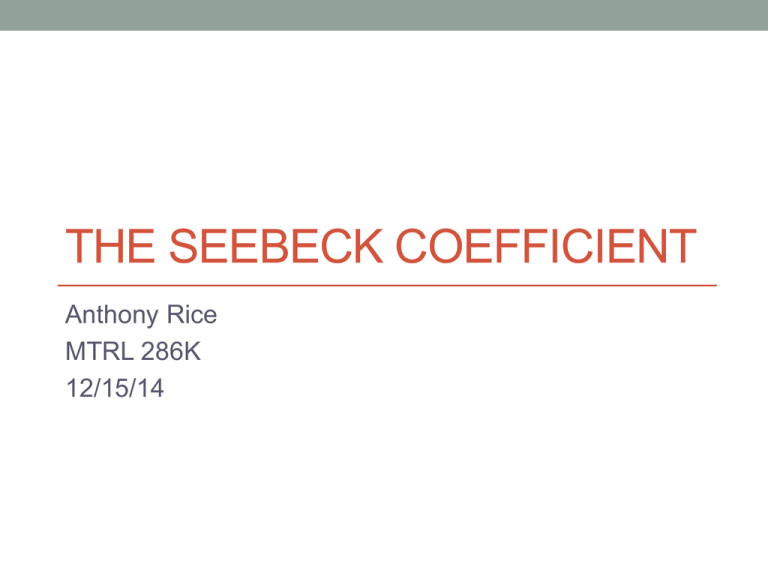
THE SEEBECK COEFFICIENT Anthony Rice MTRL 286K 12/15/14 Outline • The Seebeck coefficient is a property dependent on the electronic structure near the fermi-level and is sensitive to things including effective mass, carrier concentration, and band shape • Seebeck measurements may be used to further elucidate basic electronic properties through a transition • NaCo2O4 is a high-Seebeck metal, with possible explanations including configurational entropy and peculiar band shape The Seebeck Effect ∆𝑉 𝑆=− ∆𝑇 μ𝑉 [ 𝐾 “Power Factor” ] -Direct Eg, Parabolic bands J. Solyom. Fundamentals of the Physics of Solids A. Shakouri. Annu. Rev. Mater. Res. 2011. 41:399–431 Typical Metallic Values Sign determines whether dominant conduction occurs below or above fermi level J. Solyom. Fundamentals of the Physics of Solids “Mott Formula” For a Metal/degenerate-semiconductor: M. Cutler, N.F. Mott. Phys. Rev. 181, 1336 (1969) Generalized For a Semiconductor: τ-carrier lifetime v-group velocity ε-band dispersion A- material dependent constant J. Solyom. Fundamentals of the Physics of Solids H. Fritzsche,Solid State Commun.9, 1813 (1971) Pisarenko Plots • Seebeck vs. n plot, generally log-log • Should be a universal relationship for a given band-structure/material • Slope ~200 μ𝑉/k for a parabolic band insulator • k/e∗ln(10) B. Jalan, S. Stemmer. Appl. Phys. Lett. 97, 042106 (2010) PbTe:Tl Solid line-calculated/published to date Dots-Current study J.P. Heremans. V. Jovovic. E.S. Toberer. A. Saramat. K. Kurosaki. A. Charoenphakdee. S. Yamanak, G.J. Snyder. Science 25 July 2008: Vol. 321 no. 5888 pp. 554-557 V1-XWxO2: TMI vs. Ts T. Katase, K. Endo, and H. Ohta. Phys. Rev. B 90, 161105(R) (2014) V1-XWxO2:Parabolic Bands? T. Katase, K. Endo, and H. Ohta. Phys. Rev. B 90, 161105(R) (2014) Magnetite at the Verwey Transition • • Oxidation varied-A least oxidized, E most Above ~120K-independent of oxidation -Provides a probe of carrier type without B-field A.J.M. Kuipers and V.A. Brabers. Phys. Rev. B. 14, 1401 (1976) Thermopower in the Correlated Hoping Regime • Seebeck governed by entropy change due to addition of one more carrier in cases of interacting carriers at high temperatures “Heikes formula” P.M. Chaikin, G. Beni. Phys. Rev. B. 13, 647 (1975) NaCo2O4 • Na/CoO2 Layered Structure • At stoichiometry, Co valence +3.5 I. Terasaki, Y. Sasago and K. Uchinokura. Phys. Rev. B 56, R12 685 (1997) Initial explanation- Hopping due to degeneracy g3, g4.-# of configurations for each valence x-ratio of 3+/4+ states (depends on xna) Degeneracy, plus 3d correlation effects causes large S W. Koshibae, K. Tsutsui, S. Maekawa. Phys. Rev. B. 62, 6869 (2000) ARPES Results Missing crossings near K point Na0.7CoO2 D.J. Singh. Phys. Rev. B. 13397 (2000) H.-B. Yang et al. Phys. Rev. Lett. 92, 246403 (2004) Na0.6CoO2 M. Z. Hasan et at. Phys. Rev. Lett. 92, 246402 (2004) “Pudding mold” Bands K. Kuroki, R. Arita. J. Phys. Soc. Jpn. 76, 083707 (2007) Fe(As1-xSex)2 Pnnm (no. 58) H. Usui, K. Suzuki, K. Kuroki, S. Nakano, K. Kudo, M. Nohara. Phys. Rev. B. 88, 075140 (2013) Summary • The Seebeck coefficient provides useful information beyond resistivity for basic electronic studies • Metal-insulator studies may be further enhanced by using thermopower measurements • A number of materials with unique band-structure may be potential candidates for further thermoelectric study CuAlO2-Proposed Hole-doped TE K. Mori, H. Sakakibara, H. Usui, K. Kuroki. Phys. Rev. B. 88, 075141 (2013)
